HP Z210 SFF Workstation: Serious Power in Cramped Quarters
by Dustin Sklavos on August 29, 2011 8:10 PM EST- Posted in
- Systems
- IT Computing
- Intel
- HP
- Xeon
- Quadro
- Workstation
- SFF
- Enterprise
- NVIDIA
Gaming and Workstation Performance
The gaming benchmarks here are for academic purposes only: as mentioned before, the NVIDIA Quadro 600 isn't a gaming card (nor is the Quadro 2000 in the Dell Precision T1600 for that matter). However, they do set up an excellent framing device for when we get to the workstation-class, OpenGL-based benchmarks later on.
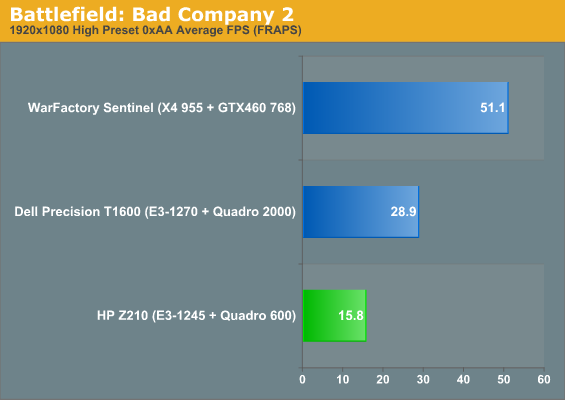
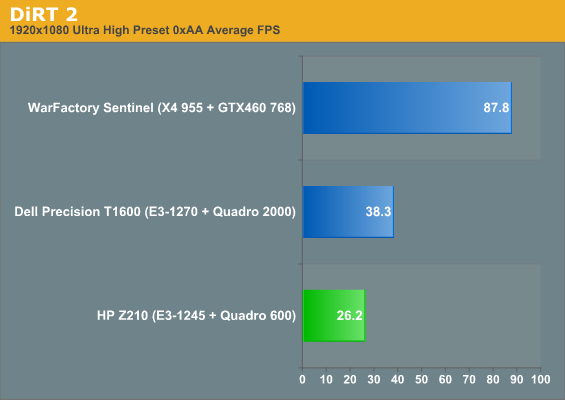

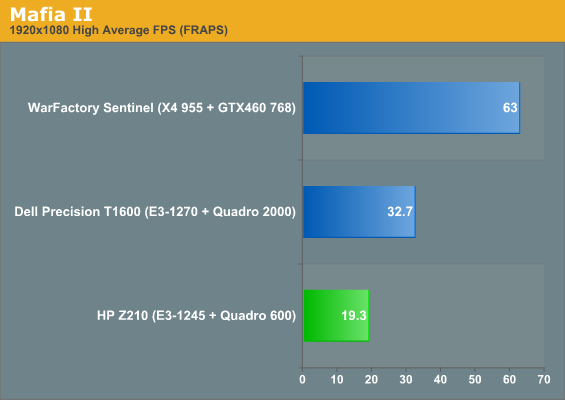
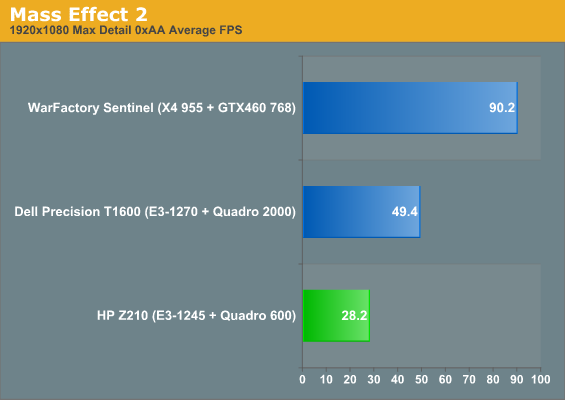
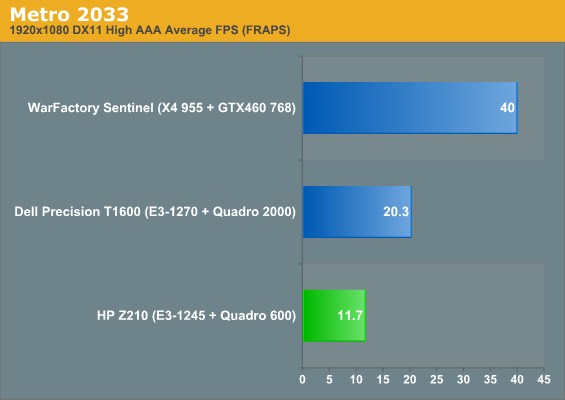
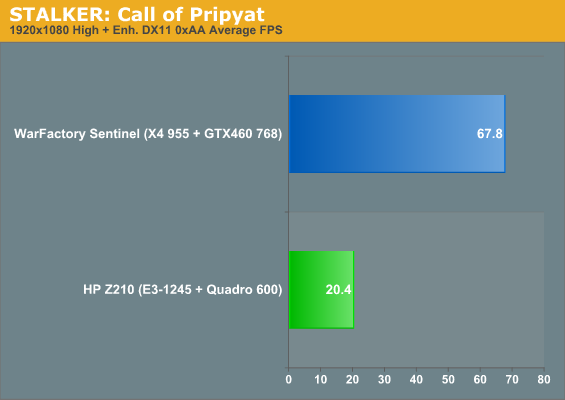
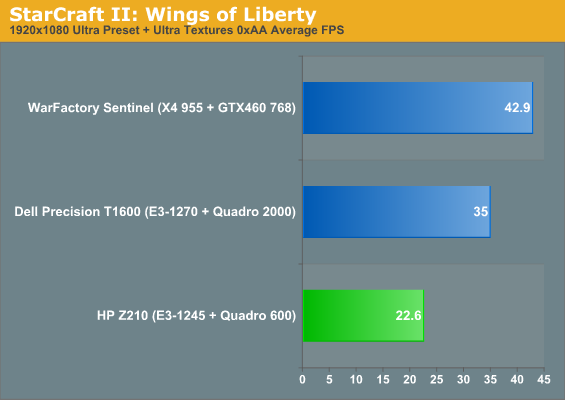
Our gaming suite is designed to beat on powerful, gaming-oriented desktops until candy comes out of them; an underclocked GeForce GT 430 was never going to be much of a gaming card to begin with, especially not at these settings. I do still think the Quadro 2000 is a compelling card due to its form factor and single-slot cooler, and thankfully a consumer-grade analogue is starting to materialize in the form of the GeForce GT 545.
As you'll see when we get into our workstation benchmarks, hardware really isn't everything. We're sticking with SPECviewperf 11 since it seems to be a pretty popular standby and good for producing a performance metric of a cross section of OpenGL-based applications, but also adding SPECapc for Lightwave 3D 9.6 and Premiere Pro Benchmark for CS5 (run in CS5.5). As a special bonus, we've also included the test results from the HP EliteBook 8760w we recently reviewed. The Quadro 5010M in the 8760w is the mobile equivalent of the GeForce GTX 560 Ti in terms of silicon, but clocked substantially lower. Ultimately it should actually be fairly comparable in hardware power to the GTX 460 768MB used in the gaming testing. And finally, to both pad out the tables and give you some idea of just what workstation cards can do, I've included test results of my personal desktop, sporting a Core i7-990X ES (thank you AVADirect) and GeForce GTX 580.
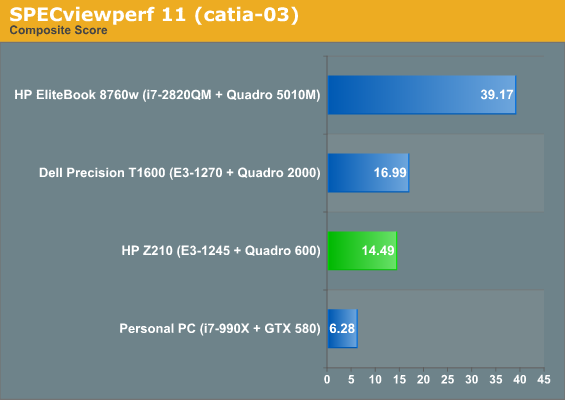
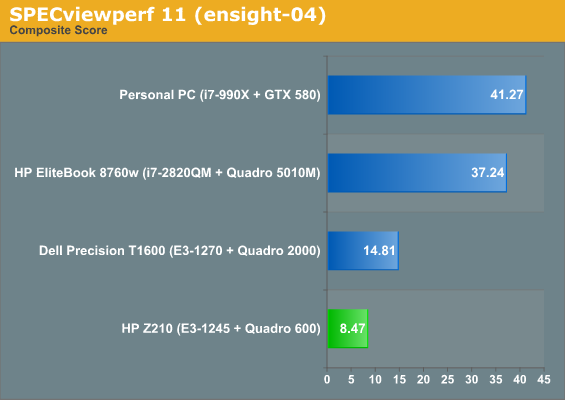
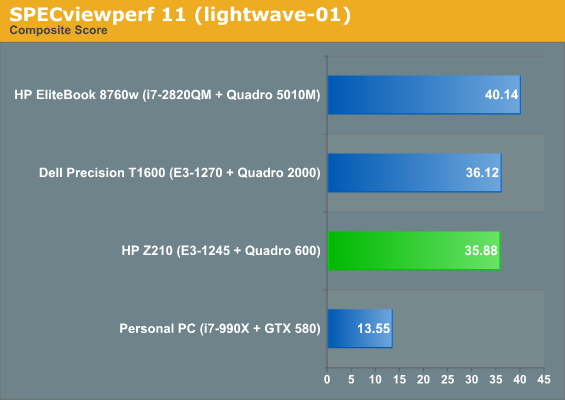
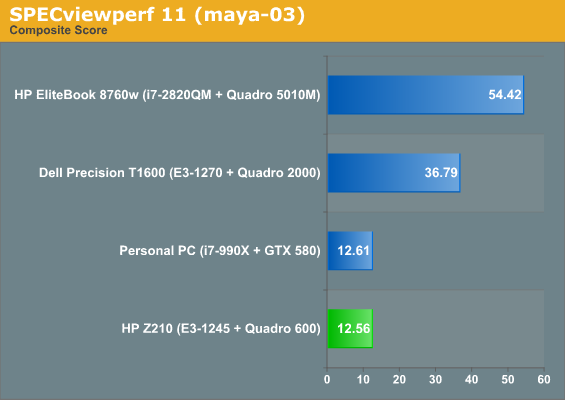
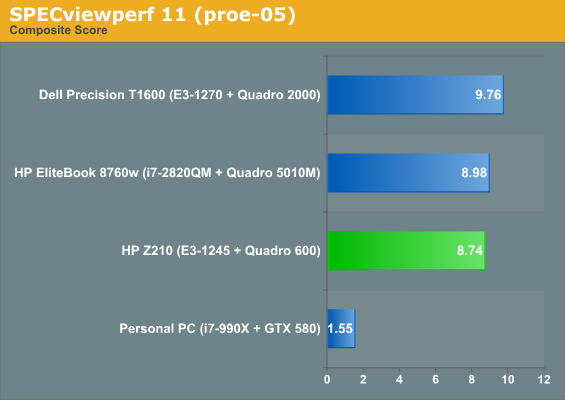
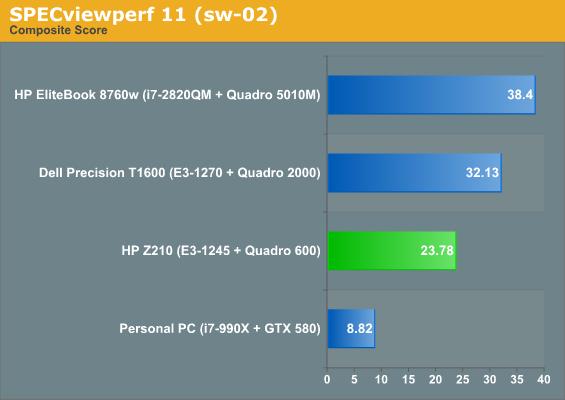
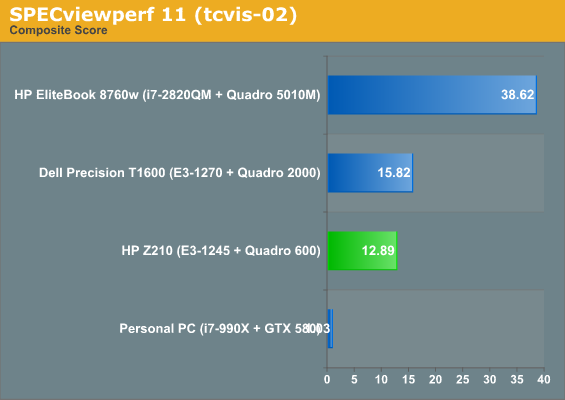
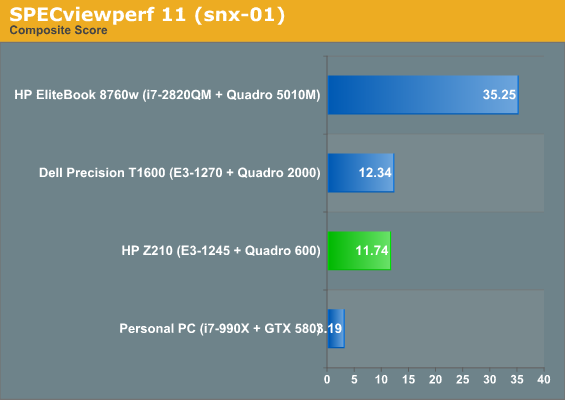
Well, right off the bat, the most amusing thing is the way the Quadros just mercilessly brutalize the GeForce GTX 580. Without the OpenGL optimizations the Quadros benefit from, the GTX 580 lags horrendously behind even the lowly Quadro 600. Those of you looking to build a workstation for 3D modelling on the cheap would do well to pay attention here: a $170 Quadro will generally murder a $400+ GeForce, let alone anything slower, and it stands to reason the competitively priced AMD FirePro cards will offer similar advantages over garden variety desktop cards.
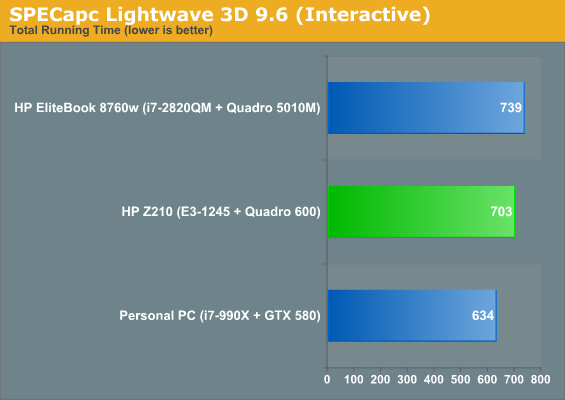

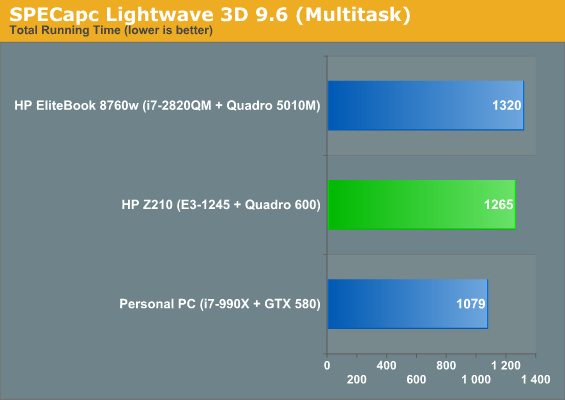
The Lightwave 3D 9.6 benchmarks tell a similar tale to the SPECviewperf 11 tests, but at least the difference isn't quite as massive here. While Lightwave will still definitely benefit from a Quadro or FirePro graphics card, at least the GTX 580 isn't completely dragging its heels. We'll have to do more tests, but it seems like this application benefits from a more balanced system; while the E3-1245 in the Z210 is a faster processor than the Core i7-2820QM, the EliteBook 8760w benefits from a much faster GPU and seems to eke out a lead there. Meanwhile, the i7-990X may boast ultimately more CPU horsepower than either system, but the consumer-oriented GeForce GTX 580 drags it down.
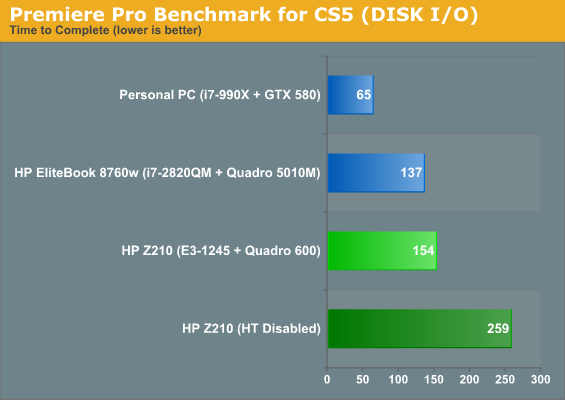
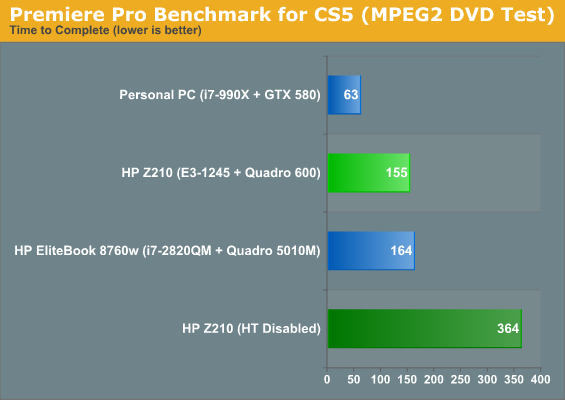
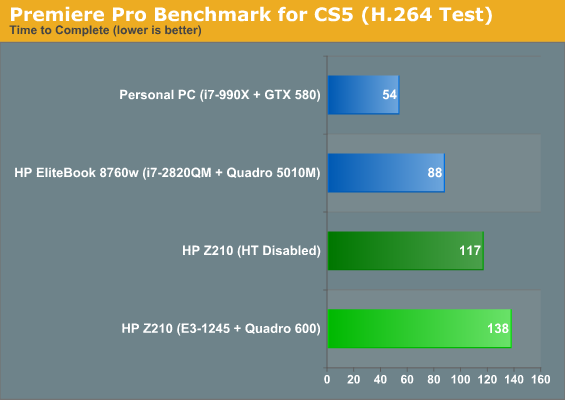
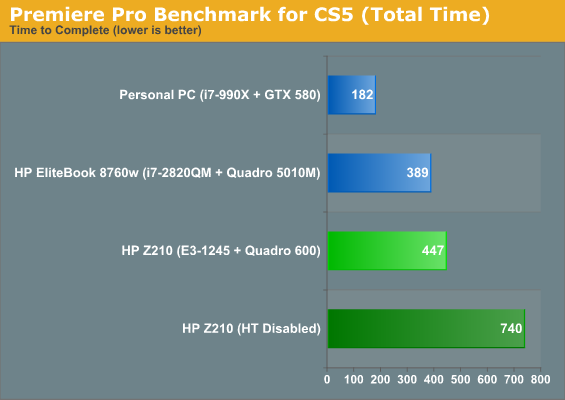
Meanwhile there's the Premiere Pro Benchmark for CS5, the details of which can be found here. Truthfully, while this benchmark seemed like a reasonable inclusion I've found myself a bit disenchanted with it, as the results are nowhere near as consistent as SPECapc or SPECviewperf, much less the x264 encoder or Cinebench.
There are a few points to break down here. First, HP's Performance Advisor actually suggests disabling Hyper-Threading when running Adobe Premiere Pro, which runs completely counter to common wisdom involving video editing software and particularly Premiere Pro. Sure enough, losing Hyper-Threading results in a massive performance hit. Only the H.264 test benefits from disabling it, everything else takes a swan dive.
Second, PPBM has a method for measuring performance gains involved with having the Mercury Playback Engine GPU accelerated, but the results are of questionable value. Five times faster than what? Which is part of the problem with MPE's CUDA acceleration; I've asked NVIDIA's engineers just what exactly is accelerated and the answer is always foggy, so on that point I'll spell it out for you fairly clearly: while I haven't seen any notable performance improvements while encoding video, working with streams in realtime on the timeline is noticeably different.
I think the biggest takeaway is that the ordinarily performance-hungry AVCHD becomes vastly easier to edit in realtime; I've seen it chop on the timeline on an i7-930, but add a GeForce GT 240 with 1GB of GDDR5 to an Athlon II X4 and edit the list of enabled cards (the list of cards enabled is artificially limited but it's moronically easy to alter) and suddenly it's buttery smooth. At this point I would say hardware-accelerated MPE is basically essential for any editor using Premiere Pro, and it's my understanding there are more and more of you out there now that Apple royally screwed the pooch with Final Cut Pro X. Welcome to the club; we've had 64-bit support and GPU acceleration for over a year now, and you can even import the FCP7 projects that FCPX doesn't support. I knew I wasn't stubborn, I was just ahead of my time.
Where were we? Oh yeah, the shortcomings of PPBM. Finally, I noticed test results varied pretty substantially between runs, and if you look at the results chart on the PPBM website you'll notice very little rhyme or reason among how the systems rank versus how they're configured. There are broad strokes, but a whole lot is lost in the minutiae.
Ultimately I'm not sure if we should keep using PPBM, so please sound off on the comments and let us know what you think, as well as letting us know if you have any suggestions for additional benchmarks for workstations.










25 Comments
View All Comments
The Von Matrices - Tuesday, August 30, 2011 - link
I thought BTX was dead due to the rise of integrated memory controllers (difficult memory trace layout), but it's used in this case. I'm sure you couldn't get nearly as good thermal performance with an ATX layout, which is why I wish BTX had caught on in the build-your-own market.jecs - Tuesday, August 30, 2011 - link
I builded a minitower PC back in december 2010 and it happens to include a 2600K and a Nvidia Q600 + 8 MBs of memory and W764. It is a great system and it was about $1500 from Newegg, Amazon and a local CompuUSA. So it is a mixed commercial PC with an entry Quadro to run 3D apps, mostly Maya 2011, but I run 3D terrain modelers, Photoshop or gaming engines with an Nvidia 460 installed on another slot (both cards at the same time). It runs very well and stable, I haven't overclocked the CPU but is really fast. For comparison it renders one image using Maya software or Mental Ray as fast as my Mac Pro 2008 with 8 Xeon cores at 2.8 MHz. But at some other rendering jobs as toonshading the 2600K doubles the Mac Pro performance (because the memory subsystem in the newer i7). However the Mac Pro is the machine I run all day and night and it is as stable as it possibly can be, it never fails and it runs cool and silent. But for 2K the HP including a Xeon is very competitive. Also the size (not the shape) is appealing to me.I need a Mac for FCP and because I have a ton of images, references, fonts, software, devices connected I like OSX and I am proficient using the Mac. I will upgrade the MP at the end of this year. I am thinking to try the top iMac that includes the 2600K, but I am afraid the iMac wont be able to handle all the demanding job the Mac Pro does or it may not be as easy to upgrade, handle everything, exchange HDs. etc The Mac Pro is a very solid workstation based on Xeon technology.
An experience I can share is the BIG difference a Quadro makes in Pro 3D, it is not only the performance numbers you can digest. I tested the 460 alone and it is a horrible card for that. The Q600 produce an image in the viewport the 460 can't touch.
I am glad I have both machines to run what I need at critical times and now I will always have both the Mac and PC combination. It gives me literally 2 eyes to try many things and I do.
Great article and Please keep doing Xeon and workstation reviews.
Dustin Sklavos - Tuesday, August 30, 2011 - link
Do me a favor and humor me, because I do my video editing on the PC side (I know, I'm weird) on Adobe Premiere CS5.5: how has the switch from FCP7 to FCPX affected you?jecs - Tuesday, August 30, 2011 - link
It hasn't yet! because I did not "upgraded" immediately (clever me) but it was shocking to know Apple's new strategy and in general the massive complains it generated and why. Being an early adopter has been hard on me lately on both Mac (Software and hardware) and PC (hardware). I guess I will investigate in detail how the new FCPX will affect me and when I feel confident I will upgrade. As for Premier Pro I guess I will download the trial and see how it works before the upgrade to FCPX.On the humor side everything is working great now, thanks! but what a pain it is to discover you want to desperately go back and stay there (if you can).
Parhel - Tuesday, August 30, 2011 - link
Looks quite similar to SFF version of the Optiplex 990. The have an Ultra SFF as well, but it doesn't have an expansion slot for discrete video. I was considering one of those as the base for an HTPC build. Only thing that held me back was 2-channel sound. Would be interesting to see how this compares.koinkoin - Tuesday, August 30, 2011 - link
Well what you would need is a video card with HDMI audio support.I got it in an optiplex 960 and works like a dream, you can get a AMD low profile card that would fit in there I guess.
GTVic - Tuesday, August 30, 2011 - link
While one Anandtech reviewer recently referred to HP as a slow moving company, compared with Lenovo, as stated in this article, they do come up with enterprise hardware using the latest technology fairly quickly.In our organization we migrated to Windows Vista about 3 years ago and are about to move to Windows 7 next year. The hardware we received at the time was reasonable but already more than a year old in terms of when the chip hardware was released by Intel. I have a Lenovo S10 workstation that takes 90-120 seconds to boot up when you factor in all the corporate crap and is not noticeably faster than their standard desktop. They are proposing to replace this NEXT YEAR with the "BRAND NEW" S20 which can be found in reviews dating back to August 2009 (PCMag).
We should be getting this type of equipment and the EliteBook or ProBook laptops and higher end workstations as needed instead of the Lenovo one-size fits all crap we are getting now.
Death666Angel - Tuesday, August 30, 2011 - link
Hello!Thanks for the article (haven't read it all, yet), but I wanted to ask you if you can also post the measurements of the case in the metric system (mm or cm) for your international viewers. Anandtech sometimes has both, sometimes just the metric one and sometimes just the imperial one.
It would be much appreciated.
Toshio - Tuesday, August 30, 2011 - link
Thanks for the article! Tho I like to build my own gaming pc for home, at work we're considering workstations like this because of service, warranty, etc. I'm stunned by the OpenGL performance of the Quadro 600 card, didn't think there was such a gap compared to GTX580-class GFX.Only one question: this SFF system uses a proprietary PSU, right?
mike_ - Tuesday, August 30, 2011 - link
CS5 benchmarks are all well and good, but I would reckon if you're in the market for one of these then you're in either engineering (ie, CAD or similar) or development, and the benchmarks covered neither.Linux performance would have been a welcome comparison also, as 7 can be a bit tiresome running workstation loads at times. Perhaps pull some of the server benchmarks out here? With something like this it won't be uncommon to run several server applications + virtual machines + development tools on the same box.